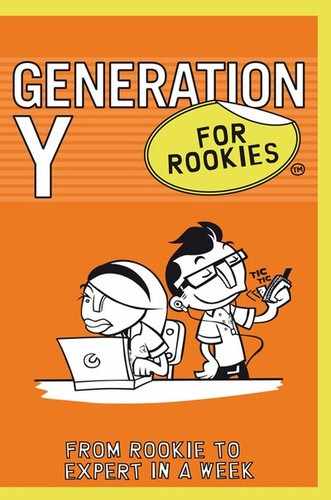Introduction
There is so much being written and discussed today on the subject of Generation Y – those people born between 1980 and 2000 (in other words, those under 30 at the time of writing). The discussion usually centres on how different they are from the other generations, and often features exasperation by those doing the commenting. There appear to be two distinct views of Generation (or Gen) Y. One is that their expectations are too high, they are far too demanding and impatient, and they need to change their attitudes if they are to fit into the world of work. The other is that they are a talented, interested and energetic group of people who will be key to helping organizations change and innovate in the years ahead.
Whatever your own view, Gen Y is a group of people that is important for organizations today. Because of global demographic changes, young talent is going to get scarcer and scarcer. At the time of writing, some of the big professional services companies’ workforces are 40–50 per cent made up of under 30s, and currently 20 per cent of the UK workforce is drawn from Gen Y. When half your workforce has different values, attitudes and motivations from the other half, it’s a good idea to understand them. If you don’t, you could end up struggling to get and keep the talent you need to run your business now and in the future.
Many organizations are becoming concerned about their ability to attract, retain and motivate Gen Y. I will stress at this point that I am not advocating pandering to or changing the workplace just for the sake of these under-30s. What I am suggesting is that a working environment that works equally well for all generations is a good thing. If you can motivate all of your employees, irrespective of their age, then they are likely to be more engaged and therefore more effective and productive.
Gen Y is certainly challenging prevailing organizational cultures, ways of managing and people practices. Some would say that the changes Gen Y is demanding are long overdue. I would certainly argue that much of what Gen Y wants from work, Baby Boomers (those born between 1946 and 1964) and Generation X (those born between 1965 and 1979) would have quite liked too, but unlike Gen Y they were conditioned not to expect it. Some see Gen Y as a problem, or at least a challenge. Others see them as an opportunity. Whatever your viewpoint, ignore Gen Y’s changing needs at your peril.

This book is written for those who are interested in understanding more about Generation Y: managers, teachers, parents, and anyone else who is interested in finding out how to attract, motivate, manage and communicate with them – or just relate well to them. Usually (though not always) these people will be of an older generation – probably either Boomers or Gen X.
A word of caution at this point. I will be referring to the different generations’ characteristics throughout this book and, for ease of explanation, generalizing about them. However, it is important to point out that it is of course impossible to generalize across an entire age group. I know some people aged 50+ who are more Gen Y in attitude than a couple of my twenty-something acquaintances. Generational mindset is more to do with attitude than age. The characteristics I describe will be true of most Gen Ys, but there will always be “outliers” – in other words, those who do not exhibit these characteristics. And there are differences between Gen Ys in different cultures.
The insight and knowledge contained in this book comes from two years of researching, studying and working with Gen Y and their older colleagues in organizations in the public, private and third sectors. I first became interested in Gen Y when I worked at The Economist Group (publisher of The Economist magazine). I noticed that the advertising and marketing sectors had identified this generation as being different from the rest of us. They had marked Gen Y out as a segment with a distinct psychographic profile, one that needed different kinds of messages and communications media.
I had also noticed that younger people who were joining The Economist Group were different from their older colleagues. Even compared with others in the challenging Economist Group culture, these young people were pushing beyond what their colleagues from other generations would tolerate.
Then in 2006 Maurice Saatchi, one half of the Saatchi brothers, major players in the advertising world, predicted the death of the 30-second television advert. He hypothesized that a number of different factors contributed to advertising being “cut down in its prime”. These factors are sociological (families no longer sit together to watch television), technological (most households have a whole lot of technology and applications competing for attention, including computers, iPods, games and social computing technologies), and psychological. (The psychological factor relates to how the world is divided into “digital natives” and “digital immigrants”, the young being digital natives: they learn technology like they learned their mother tongue. The rest of us – immigrants – will always have an “accent” and have to “translate”.) Finally, Saatchi argued that the digital native’s brain has come to be physically different as a result of the way it interacts with technology: “It has re-wired itself. It responds faster. It sifts out. It recalls less.” This explains why young people are good at multitasking and can send instant messages while working on their laptops, listening to music on their MP3s and watching TV, all at the same time. This multi-tasking results in a phenomenon called Continuous Partial Awareness (CPA). The upshot, said Saatchi, was that day-after recall scores for TV advertisements collapsed from 35 per cent in the 1960s to just 10 per cent in 1996.
The way that young people relate to media has clearly changed massively. This has far-reaching implications for anyone who is trying to sell to this consumer group. It clearly also has implications for those employing them. Back in 2006 I started to wonder why employers were not concerning themselves with Gen Y as a different and distinct category of worker. Given demographic changes and concerns about global talent shortages in particular, it seemed like a real oversight.
At that time I started to have a look at what was out there that could provide useful insight into Gen Y for employers. There were a number of books and some commentators, but it struck me that so much of what was being said was based on little or no evidence. I couldn’t find a research base to back up claims that Gen Y was substantially different from the other generations, and therefore needed to be treated differently. Nor could I find any adequate explanation as to why they were different.
That was three years ago. This book is based upon the research that my business partners and I under-took into this area. It is also, and importantly, based on all the work we have done with over one hundred clients, many of them global, from all sectors. We have worked with them and helped them to understand and grapple with real and challenging problems. And we now understand the issues in a way that is possible only when you have immersed yourself in something and struggled with it for a good chunk of time. My network of clients, contacts and mentors from all generations have provided the opportunities to acquire knowledge, insight and wisdom that has enabled me to write this very practical book. It is based on solid insight and research, and its aim is to help you make the most of Gen Y as a very valuable resource.

By the time you finish this book you will understand Generation Y and how they differ from the other generations, but also, and most importantly, how to make the most of their unique strengths and ways of doing things.


